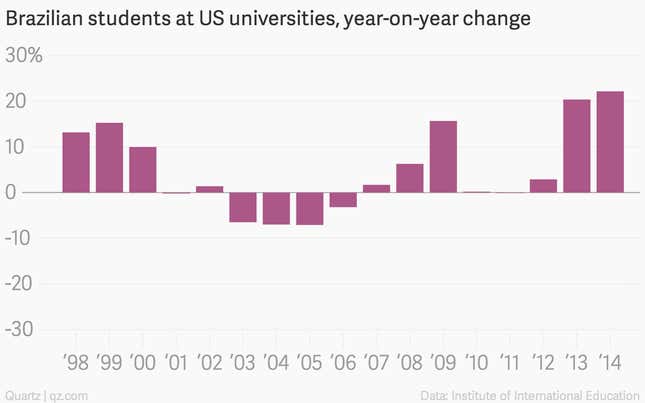In the US, there are upwards of 886,000 international students, primarily from China, India, and South Korea, which together account for about half those students. But the number of students coming from other countries, like Brazil and those in the Middle East, is growing, according to a new report out from the Institute of International Education.
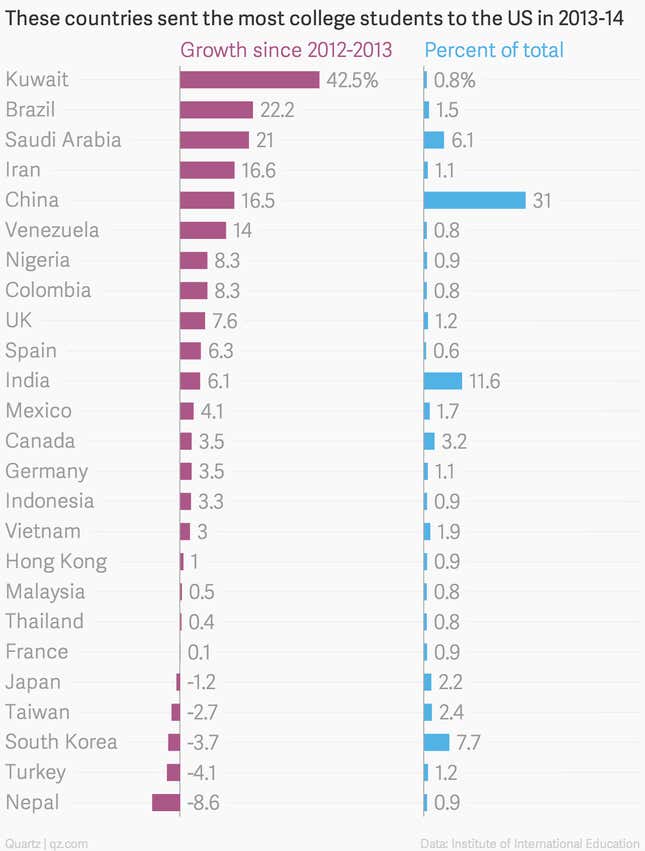
The students, both undergraduate and graduate, are coming for STEM education in particular, which accounts for more than 60% of what they’re studying, according to the annual Open Doors report. And the reasons that each country is sending more students says a lot about its economy, from a growing middle class in China to the need for a diversified work force in oil-rich Kuwait.
Here’s why some of the top countries are sending more students to the US:
China
There were 274,439 students from China enrolled at US universities in 2013-2014. The country is still responsible for sending the most students to the US, largely because the demand for higher education is greater than the number of seats available in quality institutions in China.
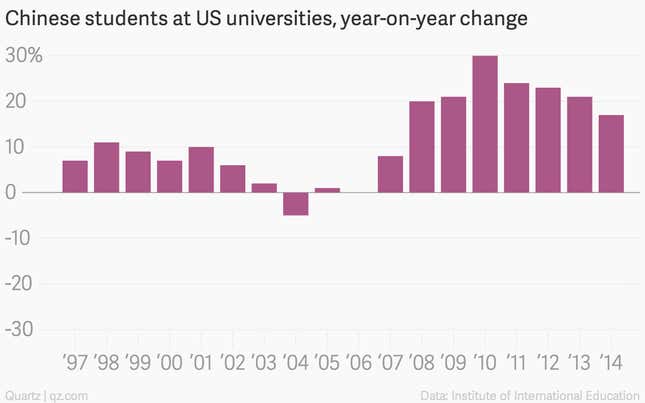
China is trying to build a system of excellent higher education, which is somewhat reflected in the dip in growth of Chinese international students coming to the US (though China still makes up 31% of all US international students). China has actually seen a tiny decrease in the number of graduate students this year compared to years past, according to a recent report from the Council of Graduate Schools. The 1% dip isn’t enough to be significant, but it’s notable that this follows a 3% decrease in graduate students the previous year, and could indicate that China is having some success in its attempts to improve higher education, says Jeff Allum, the director of research and policy analysis at the Council of Graduate Schools. China has a growing middle class, including many one-child families who want to provide the best education that money can buy for that child, says Rajika Bhandari, the deputy vice president for research and evaluation at the Institute of International Education.
India
For the last school year, India accounted for 11.6% of all international students in the US, with 102,673 students. This is the first overall increase of Indian students in the last few years, which is likely attributable to a few factors, Bhandari says. Firstly, there is a growing college- and- graduate-aged population in India, and like China, India does not have the educational infrastructure to provide quality, graduate-level education to every student who wants it; the prestigious Indian Institutes of Technology have an acceptance rate of less than 2%. The economy has also helped students make the move to the US—the Indian rupee stabilized against the dollar toward the end of 2013, which gave students more financial flexibility to study in the US, Bhandari tells Quartz. Lastly, the UK, another large destination for Indian students, saw a sharp drop in Indian students after it complicated immigration policies and raised tuition, Bhandari says.
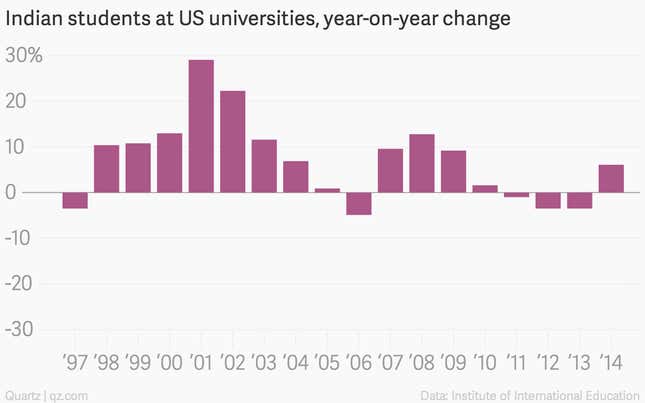
Most of the growth in Indian students is coming at the graduate level. In 2013-14, 12.3% of Indian students in the US were undergraduate students, 59.5% were graduate students, and 27% were in optional practical training, which allows foreign students to work for up to a year in their field of study before or after they graduate. Bhandari says the high number of graduate students is likely due to the fact that many of those students are coming for a STEM education, and US universities provide considerable financial aid for such graduate programs.
Kuwait
Overall, the Middle East and North Africa saw a 20% increase in students coming to the US in 2013-2014 compared to the previous year. Kuwait saw the greatest jump of all countries—42.5%—because the government provides scholarships to send students to the US, Bhandari says. Kuwaitis account for less than 1% of the international students in the US (7,288 total), but there has been consistent growth since the 2007-2008 school year—the country’s Ministry of Higher Education developed a scholarship program (pdf) in the 1950’s, but only recently expanded it to the US. The majors available for Kuwaitis, for example, vary from anthropology to STEM. The education helps diversify the workforce in a country where about 90% of export revenues come from oil.
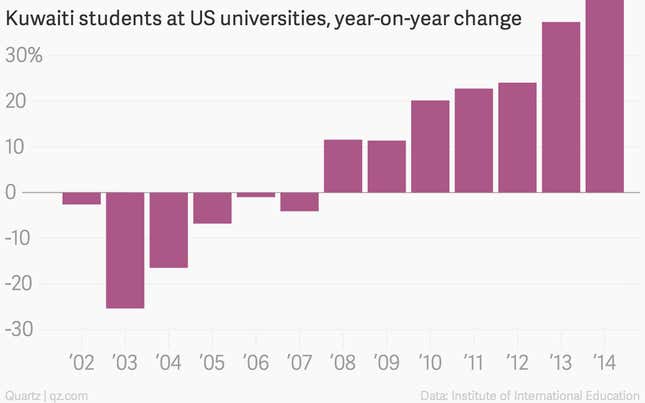
Saudi Arabia
Saudi Arabia saw a similar jump after 2005, when its King Abdullah scholarship program launched. The year after the scholarship began, the percentage of students coming to the US jumped 129% compared to the year before. Now the country accounts for 6% of all international students in the US (53,919 in 2013-2014).
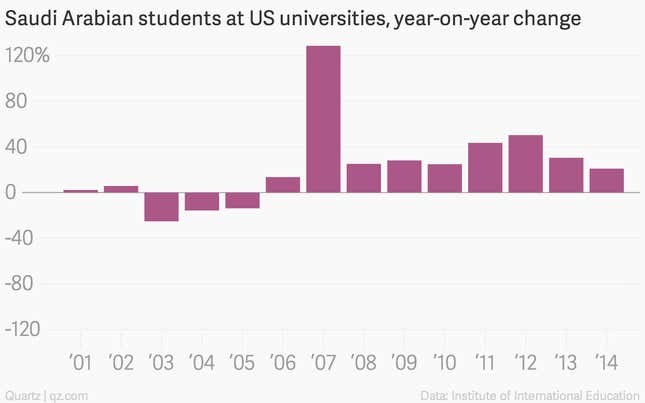
Kuwait and Saudi Arabia have seen an increase of wealth from oil as well as a growing youth population. Sending students abroad to participate in intensive English programs and undergraduate degree programs allows them to spread a positive cultural representation abroad, and it diversifies the work force, Bhandari says.
Iran
Iran has also seen consistent growth in students coming to the US, despite the bad relationship between the two countries and the government’s attempts to convince its students to study elsewhere. In 2013-2014, there were 10,194 Iranian students in the US, just over 1% of all international students.
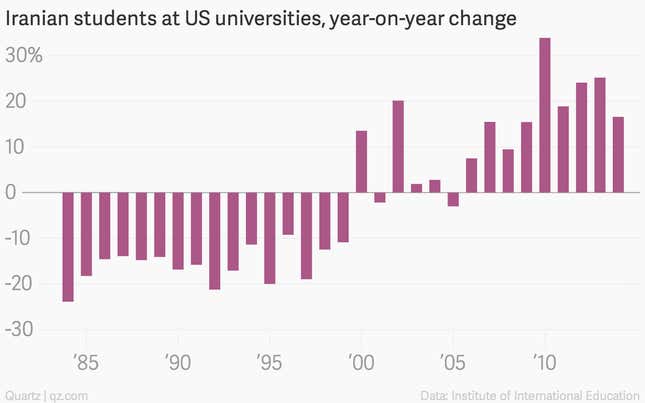
There are many connections between education in Iran and the US—Iran puts a premium on postgraduate education, and Iranian President Hassan Rouhani has more US-educated PhD’s in his cabinet than US President Barack Obama does. That may explain why there is consistent growth in Iranian students coming to the US—in 2013-2014, 81% of the students from Iran were in graduate programs.
Brazil
The government of Brazil is also sending its college students to the US, but specifically for STEM education. The Brazil Scientific Mobility Program is only for undergraduates, but it’s had the added effect of increasing graduate student enrollment in the US as well, Bhandari says. The program launched in 2011 and also funds intensive English study. There were 13,286 Brazilians studying in US colleges in 2013-2014; 38.3% were undergraduates and 23.5% graduate students. Brazil’s scholarship program helps in building its work force, which is ”critical to their national development,” Bhandari says.
